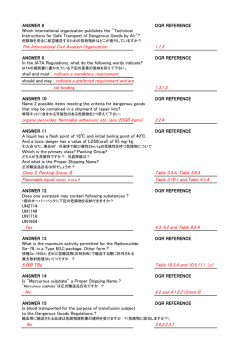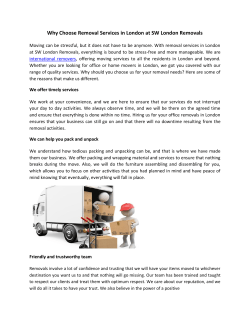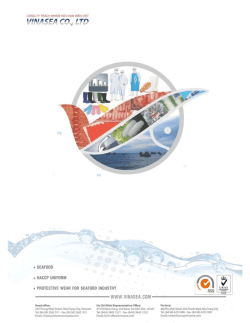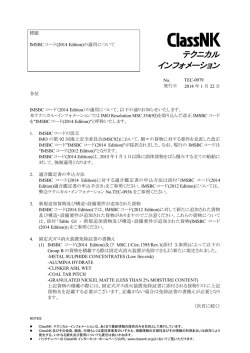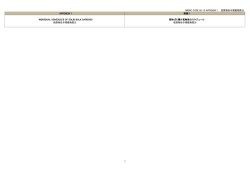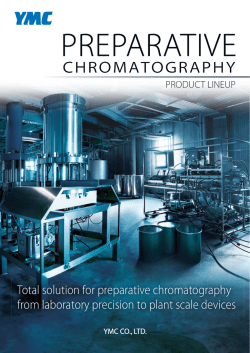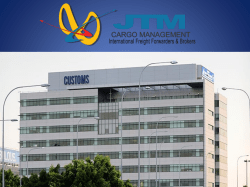
(1月8日付) が出ました。要注意 - airtransport
KINOSHITA AVIATION CONSULTANTS Website: http://www.airtransport-tozai.com 2 3 4 IATA Dangerous Goods Regulations th 56 Edition (English) Effective 1 January 2015 ADDENDUM Posted 08 January 2015 Users of the IATA Dangerous Goods Regulations are asked to note the following amendments and th corrections to the 56 Edition, effective from 1 January 2015. Where appropriate, changes or amendments to existing text have been highlighted (in yellow - PDF or grey hardcopy) to help identify the change or amendment. New or Amended State Variations (Section 2.8.2) Amend HRG (Croatia) HRG-02 The following requirements apply to aircraft registered: (a) in the Republic of Croatia no matter where they are operating; (b) in a State other than the Republic of Croatia and which are not required to operate under and in accordance with Annex III to Regulation (EC) No. 3922/1991 (EU-OPS) when they are operating in the Republic of Croatia. Aircraft may only carry dangerous goods with prior approval of the Croatian Civil Aviation Agency (CCAA). Carriage of such goods must be in compliance with the latest effective edition of these Regulations, including any addenda. Operators, AOC holders, whose head office is located in the European Union and who are required to operate under and in accordance with Annex III to Regulation (EC) No. 3922/1991 (EU-OPS) do not require the approval of the Croatian Civil Aviation Agency , providing an approval granted by such a State is held. Not used. New or Amended Operator Variations (Section 2.8.4) In 2.8.3.4 List add: After Air Berlin: Air Bridge Cargo RU After EVA Airways Evelop Airlines E9 After Iberworld Airlines: Icelandair FI After Jetstar: Jetstarasia 3K Add new 3K (Jetstarasia) 3K-01 Not Used 3K-02 Division 4.1 flammable solids, Passengers and Crew are not permitted to bring book matches onto aircraft for personal use. Book matches are only allowed as correctly packed and declared Dangerous Goods Consignment (see 2.3.5.6). 3K 03 Operator approval is required for carriage all new and used internal combustion engines (see 2.3.5.15). 3K 04 Oxygen or air, gaseous cylinders required for medical use are only accepted for transport in or as carryon baggage (see 2.3.4.1). 3K 05 Dangerous Goods in consolidation will not be accepted for carriage except for UN 1845 Carbon dioxide solid/dry ice up to maximum of 145 kg per flight when used as refrigerant for non-dangerous goods consignment. 8 January 2015 Page 1/9 IATA Dangerous Goods Regulations th 56 edition (English) Effective 1 January 2015 ADDENDUM Amend AF (Air France) AF-02 Patient specimens will only be accepted if assigned to UN 2814 or UN 2900 or UN 3373, as appropriate. They are not permitted as baggage even if exempt from the Regulations. Biological substance, Category B–UN 3373 may only be accepted for carriage under specific requirements and after a prior Air France (DZ.CA/OA.NA) written approval has been granted. Not used. Add new AF-04 Lithium metal batteries and cells, UN 3090, are FORBIDDEN as cargo on Air France cargo aircraft only. This only applies to Section I (IA and IB) of Packing Instruction 968, including those being shipped under an approval issued by an appropriate authority under special provisions A88 or A99. This prohibition does not apply to lithium metal batteries and cells, UN 3090: — shipped in accordance with Section II of PI 968. — covered by the provisions for dangerous goods carried by passengers or crew (see Table 2.3.A). — presented as Air France company materials (COMAT). Amend BR (EVA Airways) BR-06 Dangerous goods in consolidations will not be accepted for carriage, except for: consolidations having one Master air waybill with one House air waybill; or consolidations having Multi House air waybill containing ID 8000 (Consumer commodity) and/or UN 1266 (Perfumery products) and/or UN 2807 and/or Lithium batteries (UN 3480/UN 3481/UN 3090/UN 3091) with section IB/Section II; or consolidations having Multi House air waybill containing ID 8000 (Consumer commodity) and/or UN 1266 (Perfumery products) and/or UN 2807 and/or Lithium batteries (UN 3480/UN 3481/UN 3090/UN 3091) with section IB/Section II including other general cargo; or consolidations having Multi House air waybill containing UN 1845 (Carbon dioxide, solid/Dry ice) when used as a refrigerant for non-dangerous goods. (see 1.3.3, 8.1.2.4, 9.1.8 and 10.8.1.5). Amend DL (Delta Airlines) DL-06 UN 3480, Lithium Ion Batteries, Packing Instruction 965, Sections IA and, IB and II will not be accepted for transport. UN 3480, lithium ion batteries offered under Section II provisions will be accepted. Add new E9 (Evelop Airways) E9-01 Dangerous goods in excepted quantities will not be accepted for carriage (see Subsection 2.6). E9-02 Dangerous goods in consolidations will not be accepted for carriage (see 1.3.3 and 9.1.8). E9-03 Infected animals, dead or alive, will not be accepted for carriage (see Packing Instruction 620 and 650). E9-04 Class 7—Radioactive material will not be accepted for carriage (see 10.10.2). E9-05 Wheelchairs with spillable batteries will not be accepted for carriage (see 2.3.2.3 and 9.3.14). E9-06 Dry ice will not be accepted as cargo (see Packing Instruction 954). Add new EK (Emirates) EK-02 UN 3090 – Lithium metal cells and batteries, including lithium alloy cells and batteries, prepared in accordance with Section IA, IB and II of Packing Instruction 968 are forbidden for transport as cargo on Emirates cargo flights. This prohibition includes lithium metal batteries shipped under an approval in accordance with Special Provision A88 and A99 and exemption in accordance with Special Provision A201. 07/01/15 Page 2/9 IATA Dangerous Goods Regulations th 56 edition (English) Effective 1 January 2015 ADDENDUM Add new FI (Icelandair) FI-01 Maximum total Transport Index (T.I.) for radioactive materials (Class 7) on board for Icelandair operated aeroplane types is as follows: B757-200/300: Maximum total T.I. on board is 12. Maximum T.I. per compartment is 3. B757-200PF/PCF (all-cargo aircraft): Maximum total TI on board is 50. Separation minima must be observed in accordance with 10.9.3.7 and as prescribed in the Icelandair Ground Operations Manual according to aircraft type. FI-02 Dry Ice will be accepted on board Icelandair flights provided the following maximum amounts are met and complied with: Standard Dry Ice limitation Aeroplane type: Max. quantity onboard: B757-200/300: 100 kg B757PF/PCF: 300 kg For approval for increased limitations on Dry Ice please contact E-mail: [email protected] FI-03 Magnetized material may be loaded in any cargo hold of Icelandair aeroplanes, aft of flight deck. Maximum magnetic field strength is 0.002 gauss at 2.1 m distance from package. Refer to Icelandair Ground Operations Manual. Amend JL (Japan Airlines) JL-01 Not used. A unit load device (ULD) containing dangerous goods other than those indicated in 9.1.4, which is transferred from another carrier, will not be accepted, unless otherwise approved by Japan Airlines. JL-03 Type B(M) or Fissile Material Packages and/or any SCO, or LSA Materials in Industrial Packagings will not be accepted for carriage (see Subsection 10.5). Amend KZ (Nippon Cargo Airlines) KZ-10 Dangerous goods as defined in these Regulations including items exempted in permitted by Subsection 2.4 will not be accepted in air mail. This prohibition does not apply to airmail containing lithium metal or lithium ion batteries contained in equipment tendered by Japan Post Co., Ltd. Amend OM (Mongolian Airlines) OM-02 Dangerous goods requiring a cargo aircraft only (CAO) label will not be accepted for carriage. Dangerous goods shipments will only be accepted from IATA Dangerous Goods Regulations certified cargo agency/shipper. OM-03 Dangerous goods in airmail will not be accepted for carriage (See Subsection 2.4). The shipper must provide a 24 hour emergency telephone number of a person/agency who is knowledgeable of hazards, characteristics and actions to be taken in the case of an accident or incident concerning each of the dangerous goods being transported. This telephone number, including country and area code, preceded by the words Emergency Contact or 24–hour number, must be inserted on the Shipper’s Declarations for Dangerous Goods (DGD) preferable in the Handling Information box, e.g. “Emergency Contact +976-1170049998 (see 8.1.6.11). OM-04 Except for ID 8000, Consumer commodity, dangerous goods in limited quantities (“Y” packing instructions) will not be accepted for carriage (See Subsection 2.7). Documentation including Shipper’s Declarations for Dangerous Goods (DGD) must be completed in English. All package and overpack marks and labels required by these Regulations must be completed in English. OM-05 Dangerous goods in excepted quantities will not be accepted for carriage (See Subsection 2.6).The carriage of Carbon dioxide, solid (dry ice) UN 1845 is limited to a net weight of 200 kg per B767-300 and B737-800 aircraft. 07/01/15 Page 3/9 IATA Dangerous Goods Regulations th 56 edition (English) Effective 1 January 2015 ADDENDUM OM-06 Dangerous goods in consolidations will not be accepted for carriage (See 1.3.3, 8.1.2.4, 9.1.8 and 10.8.1.5).The following packagings when shipped as single packagings must be protected from damage by being overpacked to protect the top and bottom of the packaging: 1A1/1A2/1B1/1B2/1N1/1N2 3A1/3A2/3B1/3B2 6HA1 OM-07 Salvage packaging will not be accepted. Dangerous goods in airmail will not be accepted for carriage. OM-08 Class 7—Radioactive material of any kind will not be accepted for carriage (See 10.10.2).Dangerous goods in “Limited Quantities” (“Y” Packing Instructions) will not be accepted for carriage. Exception: Consumer commodity (ID 8000) will be accepted (see Subsection 2.7 and all “Y” Packing Instructions). Note: The above requirement does not apply to Company Material. Add new OM-09 Dangerous goods in consolidations will not be accepted for carriage. OM-10 Salvage packaging will not be accepted for carriage. OM-11 Class 7 Radioactive material will not be accepted for carriage. OM-12 Dangerous goods in Packing Group I will not be accepted for carriage. Note: The above requirement does not apply to Company Material-COMAT. OM-13 Dangerous goods listed in the list of high consequence dangerous goods will not be accepted for carriage. Note: The above requirement does not apply to Company Material. OM-14 Dangerous goods originating from China will not be accepted for carriage. Note: The above requirement does not apply to Company Material. OM-15 Lithium metal and or lithium alloy cells and batteries packed with or contained in equipment (UN 3091) are prohibited from carriage as cargo on OM flights/aircraft (see PI 969 and PI 970). Note: The above requirements do not apply to Company Material-COMAT. OM-16 Wheelchairs or other battery-powered mobility devices with spillable batteries will be accepted only when the battery is removed from the wheelchair or mobility device and classified as dangerous goods and carried only as cargo. Batteries attached or installed in the wheelchair or mobility devices will not be accepted (see 2.3.2.3 and 9.3.14). OM-17 Any type of internal combustion or fuel cell engines either transported individually or incorporated into another machine or equipment, even when if still in its new original packaging, will not be accepted as baggage. These items must be consigned as cargo. OM-18 Camping stoves and fuel containers that have contained a flammable liquid fuel will not be accepted for carriage in baggage. This variation applies also to used camping stoves which have been thoroughly cleaned (see 2.3.2.5). Amend OZ (Asiana Airlines) OZ-09 Dangerous goods will not be accepted for carriage as cargo on OZ's passenger aircraft with the exception of: 07/01/15 Page 4/9 IATA Dangerous Goods Regulations th 56 edition (English) Effective 1 January 2015 ADDENDUM • Dangerous goods in excepted quantities; • Radioactive materials, excepted packages; • UN 1845, Carbon dioxide, solid (dry ice); • UN 2807, Magnetized material; • ID 8000, Consumer commodity; • UN 3373, Biological substance, Category B; • UN 3166, Engine, internal combustion, flammable liquid powered, Engine, fuel cell, flammable liquid powered and Vehicle, flammable liquid powered; • UN 3091, Lithium metal batteries packed with equipment and contained in equipment (PI 969 and PI 970, Section II only); • UN 3480, Lithium ion batteries (PI 965, Section IB and II only); • UN 3481, Lithium ion batteries packed with equipment and contained in equipment (PI 966 and PI 967, Section II only). Add new QF (Qantas) QF-05 Shipments of UN 3090, lithium metal cells and batteries are prohibited from carriage on Qantas cargo aircraft. This applies to Section 1A, 1B and Section II of Packing Instruction 968. This prohibition does not apply to: UN 3091, lithium metal cells and batteries when packed with or contained in equipment in accordance with Packing Instructions 969 and 970; UN 3480, lithium ion cells and batteries when packed in accordance with Packing Instruction 965; UN 3481, lithium ion cells and batteries when packed with or contained in equipment in accordance with Packing Instruction 966 and 967; Lithium batteries when covered by the Provisions for Dangerous Goods Carried by Passengers or Crew. Add new RU (Air Bridge Cargo) RU-01 Packages with dangerous goods, primary risk of Class 8, labelled “Cargo Aircraft Only”, are forbidden for transport on lower deck of the aircraft. RU-02 UN 3090, Section IA of PI 968 and UN 3091, Section I of PI 969 and PI 970 are accepted for carriage upon prior approval of the airline. Request for approval must be via email: [email protected] Amend TZ (Scoot Airlines) TZ-04 Dangerous goods shipments will only be accepted from SIA, SIA Cargo, and Silkair and NokScoot. Amend XW (NokScoot Airlines) XW-04 Dangerous goods shipments will only be accepted from SIA, SIA Cargo, and Silkair and Scoot. Section 2 Page 26 revise note under 2.3.4.7 as shown: Note: For spare lithium metal batteries with a lithium content exceeding 2 g and lithium ion batteries with a Watthour rating exceeding 160 100 Wh see 2.3.3.2. For electronic devices with lithium metal batteries with a lithium content not exceeding 2 g and lithium ion batteries with a Watt-hour rating not exceeding 100 Wh see 2.3.5.9. 07/01/15 Page 5/9 IATA Dangerous Goods Regulations th 56 edition (English) Effective 1 January 2015 ADDENDUM Section 4 Page 367 revise Special Provision A78 as shown: A78 (172) Where a radioactive material has (a) subsidiary risk(s): (a) the substance must be allocated to Packing Groups I, II or III, if appropriate, by application of the packing group criteria in Section 3 corresponding to the nature of the predominant subsidiary risk; (b) packages must be labelled with subsidiary risk labels corresponding to each subsidiary risk exhibited by the material in accordance with the relevant provisions of 10.7.2. Corresponding placards must be affixed to cargo transport units in accordance with the relevant provisions of 10.7.5; (c) for the purposes of documentation and package marking, the proper shipping name must be supplemented with the name of the constituents which most predominantly contribute to this (these) subsidiary risk(s) and which must be enclosed in parenthesis; (d) the Shipper's Declaration must indicate the subsidiary class or division and, where assigned, the packing group as required by 8.1.6.9.1 10.8.3.9.1, Step 4 and Step 5. (e) the packaging must also be capable of meeting the appropriate performance criteria for the subsidiary risk. For packing, see also 10.3.10.1(c). Radioactive material with a subsidiary risk of Division 4.2 (Packing Group I) must be transported in Type B packages. Radioactive material with a subsidiary risk of Division 2.1 is forbidden from transport on passenger aircraft and radioactive material with a subsidiary risk of Division 2.3 is forbidden from transport on passenger or cargo aircraft except with the prior approval of the appropriate authority of the State of origin and the State of the operator under the conditions established by those authorities. A copy of the document of approval, showing the quantity limitations and the packaging requirements, must accompany the consignment. Section 5 Page 500 amend Packing Instruction 565 as shown: PACKING INSTRUCTION 565 Additional Packing Requirements Packagings must meet packing group II performance standards Oxygen generator, chemical containing oxidizing substances, including when fitted in associated equipment e.g. passenger service units (PSUs), protective breathing equipment (PBE) etc, must meet all the following conditions: Page 527 amend Packing Instruction 679 as shown: PACKING INSTRUCTION 679 Additional Packing Requirements packagings must meet packing group II performance standards; the articles must be individually packaged and separated from each other using partitions, dividers, inner packagings or cushioning material to prevent inadvertent discharge during normal conditions of transport. Page 566 amend Packing Instruction 961 as shown: 07/01/15 Page 6/9 IATA Dangerous Goods Regulations th 56 edition (English) Effective 1 January 2015 ADDENDUM PACKING INSTRUCTION 961 UN number COMBINATION PACKAGINGS Quantity per package Passenger aircraft UN 3268, Air bag inflators, Air bag modules or Seat belt pretensioners Safety devices, electrically initiated 25.0 kg Quantity per package Cargo Aircraft Only 100.0 kg … Page 580 amend Packing Instruction 968 as shown: PACKING INSTRUCTION 968 Section II Additional Requirements-Section II The words “Lithium metal batteries in compliance with Section II of PI 968” and “Cargo Aircraft Only” or “CAO” must be included on the air waybill, when an air waybill is used. The information should be shown in the “Nature and Quantity of Goods” box of the air waybill. Packages and overpacks containing lithium batteries prepared in accordance with this section must be offered to the operator separately from the goods in the consolidation that are not subject to these Regulations. Packages and overpacks in consolidations must not be loaded into a unit load device before being offered to the operator. Any person preparing or offering cells or batteries for transport must receive adequate instruction on these requirements commensurate with their responsibilities. Section 7 Page 643 amend 7.1.5.3.1 as shown: 7.1.5.3.1 Unless otherwise specified in these Regulations, packages containing environmentally hazardous substances or mixtures meeting the criteria of 3.9.2.4 (UN 3077 and UN 3082), must be durably marked with the environmentally hazardous substance mark as shown in Figure 7.1.B and in addition packages must bear the Class 9 hazard label shown in Figure 7.3.W. Note 1: The environmentally hazardous substance mark (Figure 7.1.B) may also appear on packages containing substances other than UN 3077 and UN 3082 when required by other international or national transport regulations (see 7.1.5.5). Note 2: The environmentally hazardous substance mark is not required on single packagings and combination packagings deemed “not restricted” in accordance with Special Provision A197. If a shipper prefers to send the item as Environmentally hazardous substances (UN 3077 or UN 3082 only) all applicable parts of the Regulations should be followed. Page 646 add a note under 7.2.2.3.2(a) as shown: 7.2.2.3.2 Hazard labels must conform to the following specifications: 07/01/15 Page 7/9 IATA Dangerous Goods Regulations th 56 edition (English) Effective 1 January 2015 ADDENDUM (a) labels must be configured as shown in Figure 7.3.A. The label must be in the form of a square set at an angle of 45° (diamond shaped). Except as provided in 7.2.2.3.1, the minimum dimensions must be 100 × 100 mm and the minimum width of the line inside the edge forming the diamond must be 2 mm. The line inside the edge must be parallel and 5 mm from the outside of that line to the edge of the label. The line inside the edge on the upper half of the label the line must be the same colour as the symbol and the line inside the edge on the lower half of the label must be the same colour as the class or division number in the bottom corner. Where dimensions are not specified, all features must be in approximate proportion to those shown. Dimensions for labels on cylinders must comply with subparagraph (b); Note: th Labels conforming to the specifications of the 55 edition of these Regulations where the line is not 2 mm in width are acceptable until 31 December 2016. Section 10 Page 733 amend 10.3.11.1.1.1 as shown: 10.3.11.1.1.1 A package may be classified as an excepted package if it meets one of the following conditions: (a) it contains radioactive material not exceeding the activity limits as specified in column 4 of the column headed “Materials—Package Limits” in Table 10.3.C; (b) it contains instruments or articles not exceeding the activity limits as specified in columns 2 and 3 of the columns headed “Instruments and Articles” in Table 10.3.C; (c) it contains articles manufactured of natural uranium, depleted uranium or natural thorium; (d) it is an empty package having contained radioactive material; or (e) it contains less than 0.1 kg of uranium hexafluoride not exceeding the activity limits specified in column 4 of the column headed “Materials—Package Limits” in Table 10.3.C. Page 734 amend 10.3.11.1.5 as shown: 10.3.11.1.5 Uranium Hexafluoride Uranium hexafluoride not exceeding the limits specified in column 4 of the column headed “Materials— Package Limits” in Table 10.3.C may be classified under UN 3507 Uranium hexafluoride, radioactive material, excepted package, less than 0.1 kg per package, non-fissile or fissile-excepted, provided that: Appendix D Page 843 amend contact details for Niger as follows: Niger (RN) Direction de l'Aéronautica Civile Ministère du Commerce et des Transports Chef de la Division Opérations Aériennes Division Opérations Aériennes Agence Nationale de l'Aviation Civile (ANAC) B.P. 227 Niamey NIGER Telex: 5203 MINAECI NI Tel: +227 20 72 32 67 Fax: +227 20 73 80 56 Appendix F.2 Page 896 amend contact details for Dangerous Goods Management as follows: 07/01/15 Page 8/9 IATA Dangerous Goods Regulations th 56 edition (English) Effective 1 January 2015 ADDENDUM Dangerous Goods Management Ltd 82 Richard Pearse Drive Auckland Airport NEW ZEALAND Tel: +64 (9) 275 5559 Fax: +64 (9) 275 6188 Email: [email protected] Website: www.dgm.co.nz Appendix F.3 Page 905 amend contact details for IFMA (France) as follows: IFMA–Institut de Formation aux Métiers de l'Aérien 03 rue du Te Té, Zone Cargo 4 - BAT 3437 Zone de fret 4 BAT 3437 B.P. 12036 - Tremblay en France FRANCE 95722 Roissy CDG Cedex FRANCE Tel: +33 1 48 16 37 24 Fax: +33 1 48 16 37 25 email: [email protected] [email protected] Website: www.ifma-formation.com www.ifma-formation.fr Page 909 amend contact details for Dangerous Goods Training Services (New Zealand) as follows: Dangerous Goods Training Services Dangerous Goods Management Ltd P.O. Box 53003 82 Richard Pearse Drive Auckland Airport NEW ZEALAND Tel: +64 (9) 275 5559 Fax: +64 (9) 275 6188 email: [email protected] [email protected] Website: www.dgm.co.nz 07/01/15 Page 9/9
© Copyright 2026

